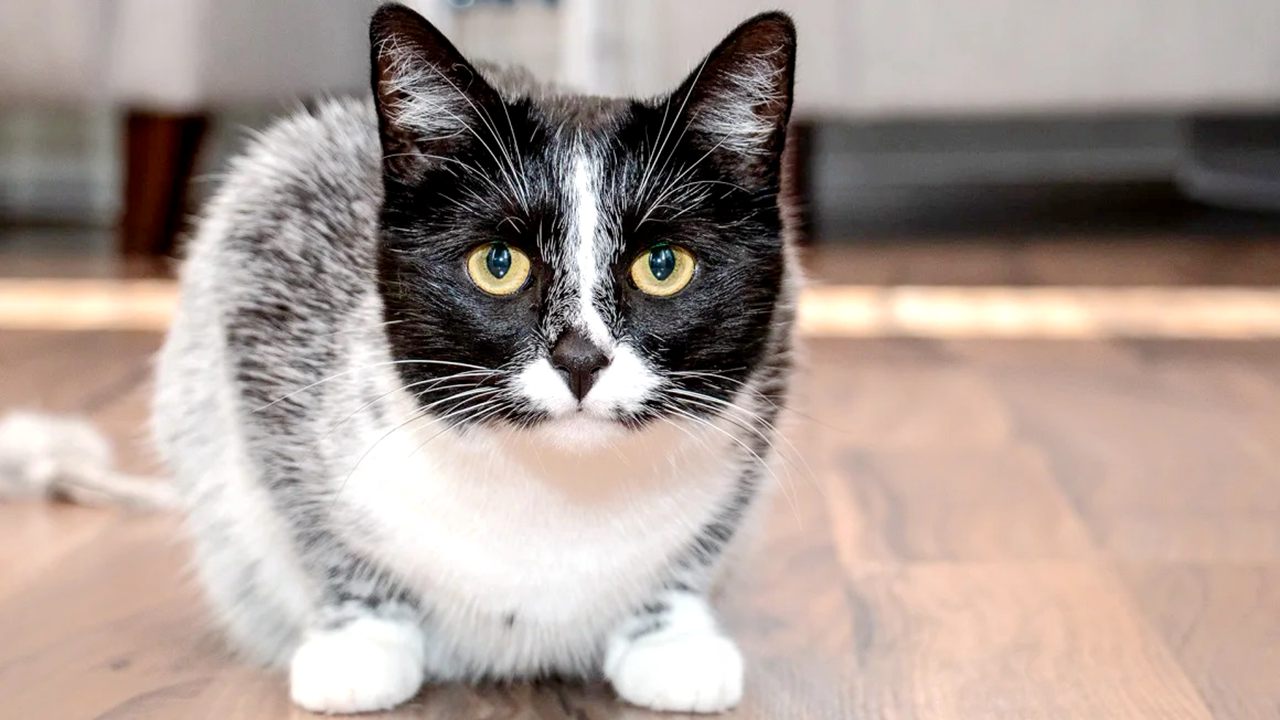Salmiak cat pattern result of genetic mutation
Writer: | Editor: Zhang Zeling | From: | Updated: 2024-06-04

Salmiak cats have ombré strands of fur that start dark at the root and fade to white. File photo
The village of Petäjävesi in central Finland is home to farmland, lakes, an 18th century wood-log church and a group of unusually striking cats. With their white chests, these creatures look similar to other tuxedo cats, but they possess a distinctive bit of flair: ombré strands of fur that start dark at the root and fade to white.
Geneticist Hannes Lohi and his collaborators at the University of Helsinki wanted to know how these cats got their look, so they studied the animals’ DNA. The team’s report, published last month in the journal Animal Genetics, found that a novel gene mutation gives rise to the exceptional fur pattern, which they dubbed salmiak, or “salty licorice,” after a popular Finnish treat.
The project was a collaboration between the university, which houses a biobank of 5,000 blood samples from more than 40 feline breeds, a pet care company that makes genetic tests, and cat owners and breeders who offered their companions’ DNA for research. “Our research approach is community science,” said Lohi, who was corresponding author on the study. “Often, the research ideas also come from cat owners and breeders having found something interesting in their pets.”
In this case, people first observed the unusual white coloring among Petäjävesi’s cats in 2007. Lohi and his team collected samples from five of them and found that none exhibited the gene variations that typically give rise to white coloration.
To home in on the genetic cause, the researchers sequenced the full genome of two of the cats and discovered a previously unknown mutation that affects a particular gene called KIT.
The team called the gene variant w-sal, for salmiak — black licorice with a speckling of white salt. The researchers tested the salty colored cats and 178 normal-colored samples from the biobank for the new gene variant. Each of the five salmiak cats had two copies of the recessive gene. A few of the other cats had one copy (not resulting in the unique color), and the rest had none.
“One of the fascinating aspects of the study is that it uncovers a really sophisticated way in which this very important KIT gene is normally regulated,” said Greg Barsh, a professor of genetics at Stanford University, who was not involved in the research.
In addition to controlling hair color, the KIT gene encodes for proteins in red blood cells and the cells that become sperm and eggs. Sometimes gene variants that give cats (and dogs) white fur can also cause deafness, though that doesn’t seem to be the case with w-salmiak. It’s one of many ways in which gene mutations that affect hair color can cause issues in other parts of the body.
The larger goal of this and other biobank work, Lohi said, “is to understand the molecular and environmental causes of feline disorders.”
The University of Helsinki has several ongoing projects with Wisdom Panel, which makes pet DNA tests, to look at the genetics of different diseases. And since genes are often similar across mammal species, what Lohi and his team learn could help not just cats but also humans with related medical conditions.
Now that salty licorice cats are officially a thing, could they become the next designer breed?
“It is possible that breeders will choose to develop a population of salty licorice cats,” Lohi said. “However, the health of the salty licorice cats should be followed in more detail to confirm the absence of any color-related health issues.” Tailored genetic testing could be used to ensure the cats are bred without passing on dangerous genes.
“If there are enough people out there that think, ‘Oh, this is really rare and they’re really cute,’ then it could become very popular,” Barsh said. “That is really more of a question having to do with the relationship of humans and companion animals than the science itself.” (SD-Agencies)
Words to Learn
相关词汇
【基因突变】jīyīn tūbiàn
mutation
the way in which genes change and produce permanent differences
【设计师品种】 shèjìshī pǐnzhǒng
designer breed
the result of controlled cross-breeding between two purebred pets
芬兰中部的佩泰耶韦西村有农田、湖泊、一座18世纪的木结构教堂和一群异常引人注目的猫。这些猫的胸部呈白色,与其他燕尾服猫似乎没什么不同,不过有一点:它们的毛发呈渐变色,根部颜色很深,然后逐渐过渡到白色。
赫尔辛基大学的遗传学家汉内斯•洛希和其他研究合著者想知道这些猫为何长相奇特,因此研究了它们的DNA。研究报告发表在上个月出版的《动物遗传学》杂志上,他们发现一种新的基因突变导致了这种特殊的毛色,他们称之为salmiak,意思是“咸甘草糖”,是一种芬兰特色零食。
该研究是赫尔辛基大学、一家宠物基因检测公司和猫主人以及育猫人共同合作的项目。该大学拥有来自40多个品种5000只猫的血液样本、猫主人和育猫人也自愿提供了部分样本。
“研究是集体成果,”该研究通讯作者洛希说。“猫主人和育猫人在宠物身上发现了不同寻常的特征,启发我们开展研究。”
2007年,人们首次观察到佩泰耶韦西的猫毛发尖有不寻常的白色。洛希和团队收集了其中五只猫的样本,发现它们都不带有其他白色动物常有的基因变异。
为了找到原因,研究人员对其中两只猫的全基因组进行了测序,发现了一种以前未知的突变,影响到一种名为KIT的基因。
研究小组将这种基因变异称为w-sal,指代芬兰语salmiak (音“萨米亚克”),意思是撒了盐霜的黑色甘草糖。研究人员对生物库中的萨米亚克猫和178个来自正常颜色猫的样本进行了测试寻找该变异基因。五只萨米亚克猫都带有两个该隐性遗传的变异基因。其他几只猫只有一个(没产生独特的颜色),其余的猫则完全没有。
斯坦福大学遗传学教授格雷格•巴什说: “这项研究令人惊奇的一点是,它揭示了KIT基因规避异常的一种复杂机制,KIT基因很重要。” 巴什没有参与该项研究。
除了控制毛发颜色外,KIT基因还编码红血细胞以及原始生殖细胞中的蛋白质。有时,让猫(或狗)长出白毛的基因变异也会导致耳聋,但w-salmiak似乎没有这个问题。影响毛发颜色的基因突变可能也会导致身体其他部位出现各种不同问题。
洛希说,这项工作以及生物库其他研究的更大目标是“了解造成猫科动物疾病的分子和环境因素”。
赫尔辛基大学与宠物基因检测公司Wisdom Panel还有其他合作项目,研究不同疾病的遗传学原理。不同哺乳动物的基因通常相近,因此洛希和团队的发现不仅能帮助猫,也可能帮助人类治疗相关疾病。
既然萨米亚克猫已经正式命名,它们会成为下一个设计师品种吗?
洛希说:“育猫人有可能会培养萨米亚克猫的种群。不过,应该对这种猫的健康状况进行更详细的跟踪,以确保这种特殊毛色的猫没有任何健康问题”。可以采用量身定制的基因测试以确保猫咪在繁殖过程中不会遗传危险基因。
巴什说:“如果有足够多的人认为‘哦,这真的很罕见,它们好可爱’,那么萨米亚克猫可能会大受欢迎。那么这就不再是科学问题,而是变成了一个关于人类和宠物关系的伦理问题。”
(Translated by Debra)